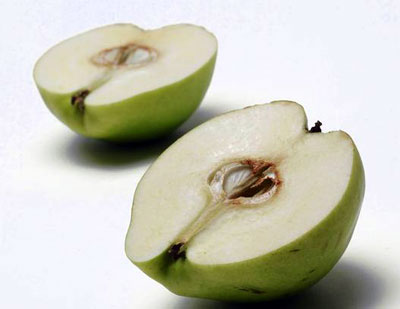 At first glance — and even, quite frankly, after extended contemplation — there is little to hint that the quince is one of the most delicious of fall's fruits. It is rough-hewn and blocky in appearance, like someone's first woodworking project gone horribly wrong. And should you make the mistake of taking a bite of it raw, that's kind of how it tastes too.
At first glance — and even, quite frankly, after extended contemplation — there is little to hint that the quince is one of the most delicious of fall's fruits. It is rough-hewn and blocky in appearance, like someone's first woodworking project gone horribly wrong. And should you make the mistake of taking a bite of it raw, that's kind of how it tastes too.
But you know about judging things on first impressions. Take that same quince, give it a little careful tending and you'll find a fruit that is utterly transformed. Cook quince — slowly and gently, bathed in just a little bit of sugar syrup — and the flesh that was once wooden and tannic turns a lovely rose hue, with a silky texture and a subtly sweet, spicy flavor that recalls apples and pears baked with cinnamon and clove.
The traditional way to cook a quince is by poaching it in spiced simple syrup. That's easy enough, but I've come to favor a slightly different technique from my old friend Deborah Madison's cookbook "Seasonal Fruit Desserts." She bakes them in a syrup made partly with white wine and spiced with cinnamon, clove and cardamom along with tangerine or orange zest.

 Parsnips. Parsnips parsnips parsnips.
Parsnips. Parsnips parsnips parsnips. Do you remember how a peanut butter sandwich always tasted better when your mom made it? Just a couple of slices of bread sandwiching peanut butter. I’d make my own sandwich and it just never tasted as good as the one mom made for me.
Do you remember how a peanut butter sandwich always tasted better when your mom made it? Just a couple of slices of bread sandwiching peanut butter. I’d make my own sandwich and it just never tasted as good as the one mom made for me. The best appetizers are full of flavor, fun to look at, and, ideally, take very little effort to prepare. Vegetable crudites fit those requirements but they aren't exciting.
The best appetizers are full of flavor, fun to look at, and, ideally, take very little effort to prepare. Vegetable crudites fit those requirements but they aren't exciting. Autumn begins this week, a season that is celebrated for the
bounties of late summer and of the harvest. And for many the season is
best represented by baking. Bread, pies, and tarts have become
synonymous with the season of change. Baking with fall fruit such as
apples, pears, plums, and quinces are a perfect way to celebrate. For me
the fruit that best represents fall is the pear. Even though most pear
varieties are picked unripe during the summer, the fruit can last in
cold storage all throughout autumn and winter. If picked ripe, the pear
is mushy, but when allowed to ripen on the counter or in a paper bag, a
pear can be the most flavorful fruit. Some criticize it for its grainy
texture, but I appreciate it for that uniqueness. The perfume of a
ripening pear is like no other fruit. With pears in mind, I decided to
put together one of my favorite tarts.
Autumn begins this week, a season that is celebrated for the
bounties of late summer and of the harvest. And for many the season is
best represented by baking. Bread, pies, and tarts have become
synonymous with the season of change. Baking with fall fruit such as
apples, pears, plums, and quinces are a perfect way to celebrate. For me
the fruit that best represents fall is the pear. Even though most pear
varieties are picked unripe during the summer, the fruit can last in
cold storage all throughout autumn and winter. If picked ripe, the pear
is mushy, but when allowed to ripen on the counter or in a paper bag, a
pear can be the most flavorful fruit. Some criticize it for its grainy
texture, but I appreciate it for that uniqueness. The perfume of a
ripening pear is like no other fruit. With pears in mind, I decided to
put together one of my favorite tarts.
